Managerial Economics - Vertical Integration
VerifiedAdded on 2022/08/27
|17
|3472
|28
AI Summary
Contribute Materials
Your contribution can guide someone’s learning journey. Share your
documents today.
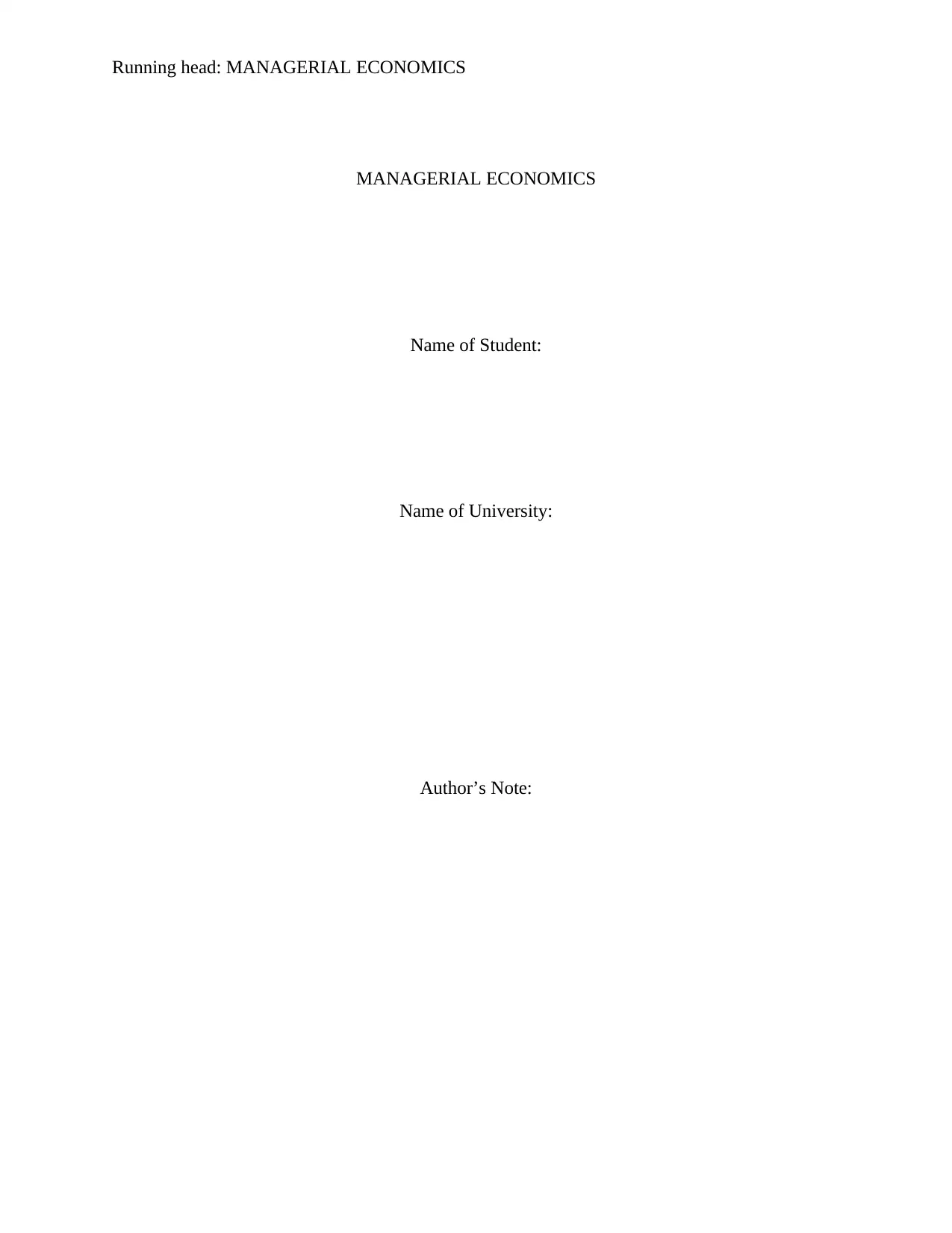
Running head: MANAGERIAL ECONOMICS
MANAGERIAL ECONOMICS
Name of Student:
Name of University:
Author’s Note:
MANAGERIAL ECONOMICS
Name of Student:
Name of University:
Author’s Note:
Secure Best Marks with AI Grader
Need help grading? Try our AI Grader for instant feedback on your assignments.
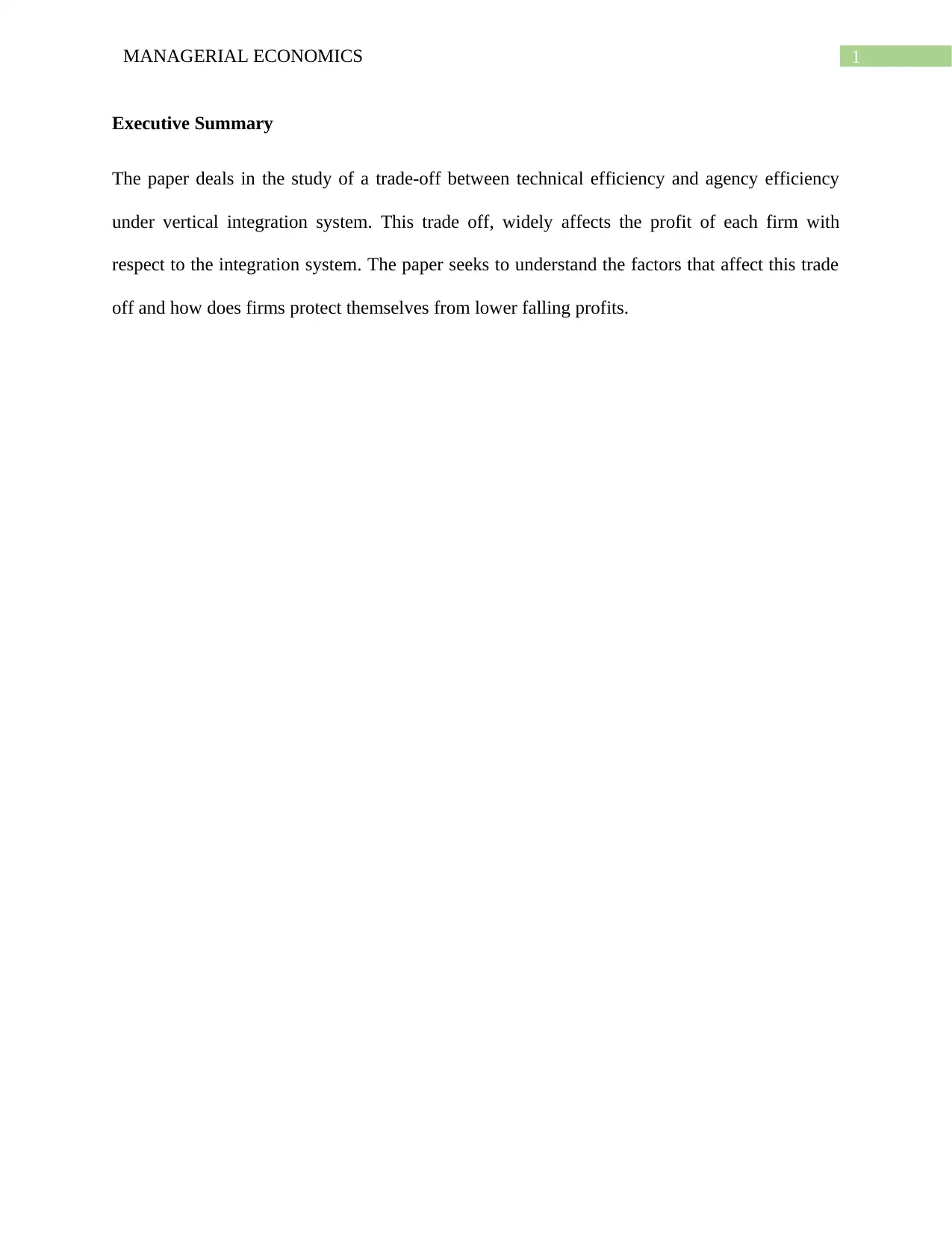
1MANAGERIAL ECONOMICS
Executive Summary
The paper deals in the study of a trade-off between technical efficiency and agency efficiency
under vertical integration system. This trade off, widely affects the profit of each firm with
respect to the integration system. The paper seeks to understand the factors that affect this trade
off and how does firms protect themselves from lower falling profits.
Executive Summary
The paper deals in the study of a trade-off between technical efficiency and agency efficiency
under vertical integration system. This trade off, widely affects the profit of each firm with
respect to the integration system. The paper seeks to understand the factors that affect this trade
off and how does firms protect themselves from lower falling profits.
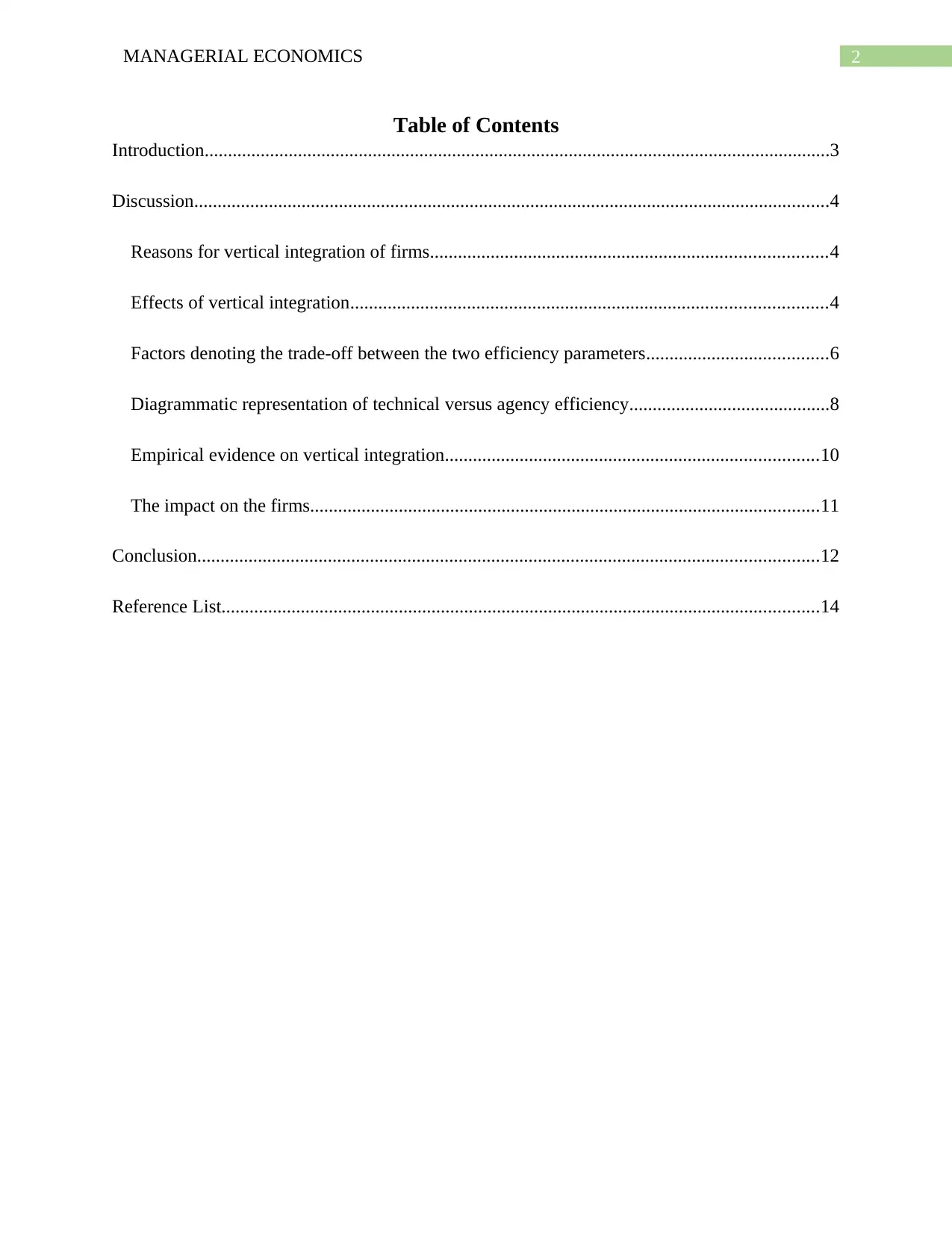
2MANAGERIAL ECONOMICS
Table of Contents
Introduction......................................................................................................................................3
Discussion........................................................................................................................................4
Reasons for vertical integration of firms.....................................................................................4
Effects of vertical integration......................................................................................................4
Factors denoting the trade-off between the two efficiency parameters.......................................6
Diagrammatic representation of technical versus agency efficiency...........................................8
Empirical evidence on vertical integration................................................................................10
The impact on the firms.............................................................................................................11
Conclusion.....................................................................................................................................12
Reference List................................................................................................................................14
Table of Contents
Introduction......................................................................................................................................3
Discussion........................................................................................................................................4
Reasons for vertical integration of firms.....................................................................................4
Effects of vertical integration......................................................................................................4
Factors denoting the trade-off between the two efficiency parameters.......................................6
Diagrammatic representation of technical versus agency efficiency...........................................8
Empirical evidence on vertical integration................................................................................10
The impact on the firms.............................................................................................................11
Conclusion.....................................................................................................................................12
Reference List................................................................................................................................14
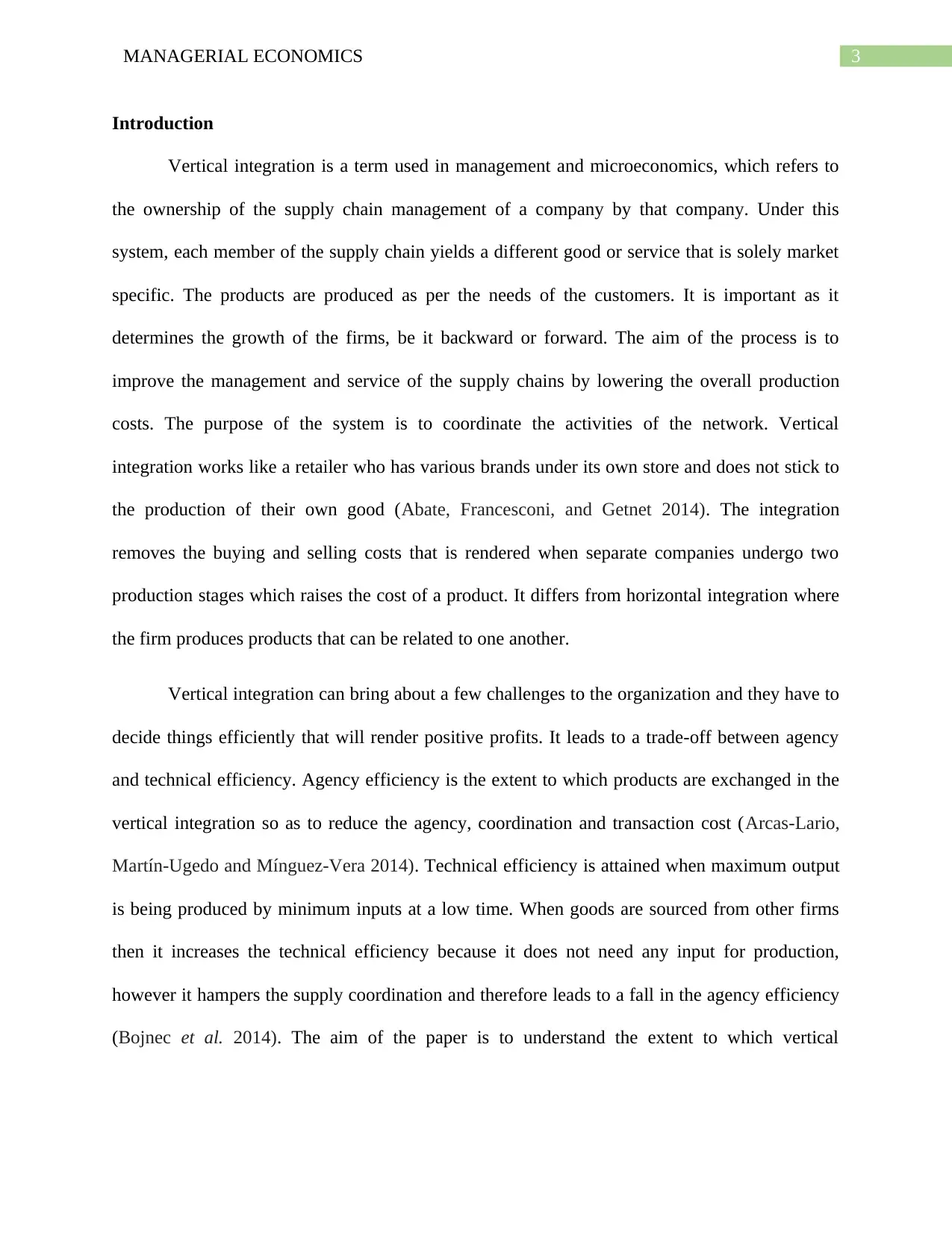
3MANAGERIAL ECONOMICS
Introduction
Vertical integration is a term used in management and microeconomics, which refers to
the ownership of the supply chain management of a company by that company. Under this
system, each member of the supply chain yields a different good or service that is solely market
specific. The products are produced as per the needs of the customers. It is important as it
determines the growth of the firms, be it backward or forward. The aim of the process is to
improve the management and service of the supply chains by lowering the overall production
costs. The purpose of the system is to coordinate the activities of the network. Vertical
integration works like a retailer who has various brands under its own store and does not stick to
the production of their own good (Abate, Francesconi, and Getnet 2014). The integration
removes the buying and selling costs that is rendered when separate companies undergo two
production stages which raises the cost of a product. It differs from horizontal integration where
the firm produces products that can be related to one another.
Vertical integration can bring about a few challenges to the organization and they have to
decide things efficiently that will render positive profits. It leads to a trade-off between agency
and technical efficiency. Agency efficiency is the extent to which products are exchanged in the
vertical integration so as to reduce the agency, coordination and transaction cost (Arcas-Lario,
Martín-Ugedo and Mínguez-Vera 2014). Technical efficiency is attained when maximum output
is being produced by minimum inputs at a low time. When goods are sourced from other firms
then it increases the technical efficiency because it does not need any input for production,
however it hampers the supply coordination and therefore leads to a fall in the agency efficiency
(Bojnec et al. 2014). The aim of the paper is to understand the extent to which vertical
Introduction
Vertical integration is a term used in management and microeconomics, which refers to
the ownership of the supply chain management of a company by that company. Under this
system, each member of the supply chain yields a different good or service that is solely market
specific. The products are produced as per the needs of the customers. It is important as it
determines the growth of the firms, be it backward or forward. The aim of the process is to
improve the management and service of the supply chains by lowering the overall production
costs. The purpose of the system is to coordinate the activities of the network. Vertical
integration works like a retailer who has various brands under its own store and does not stick to
the production of their own good (Abate, Francesconi, and Getnet 2014). The integration
removes the buying and selling costs that is rendered when separate companies undergo two
production stages which raises the cost of a product. It differs from horizontal integration where
the firm produces products that can be related to one another.
Vertical integration can bring about a few challenges to the organization and they have to
decide things efficiently that will render positive profits. It leads to a trade-off between agency
and technical efficiency. Agency efficiency is the extent to which products are exchanged in the
vertical integration so as to reduce the agency, coordination and transaction cost (Arcas-Lario,
Martín-Ugedo and Mínguez-Vera 2014). Technical efficiency is attained when maximum output
is being produced by minimum inputs at a low time. When goods are sourced from other firms
then it increases the technical efficiency because it does not need any input for production,
however it hampers the supply coordination and therefore leads to a fall in the agency efficiency
(Bojnec et al. 2014). The aim of the paper is to understand the extent to which vertical
Secure Best Marks with AI Grader
Need help grading? Try our AI Grader for instant feedback on your assignments.
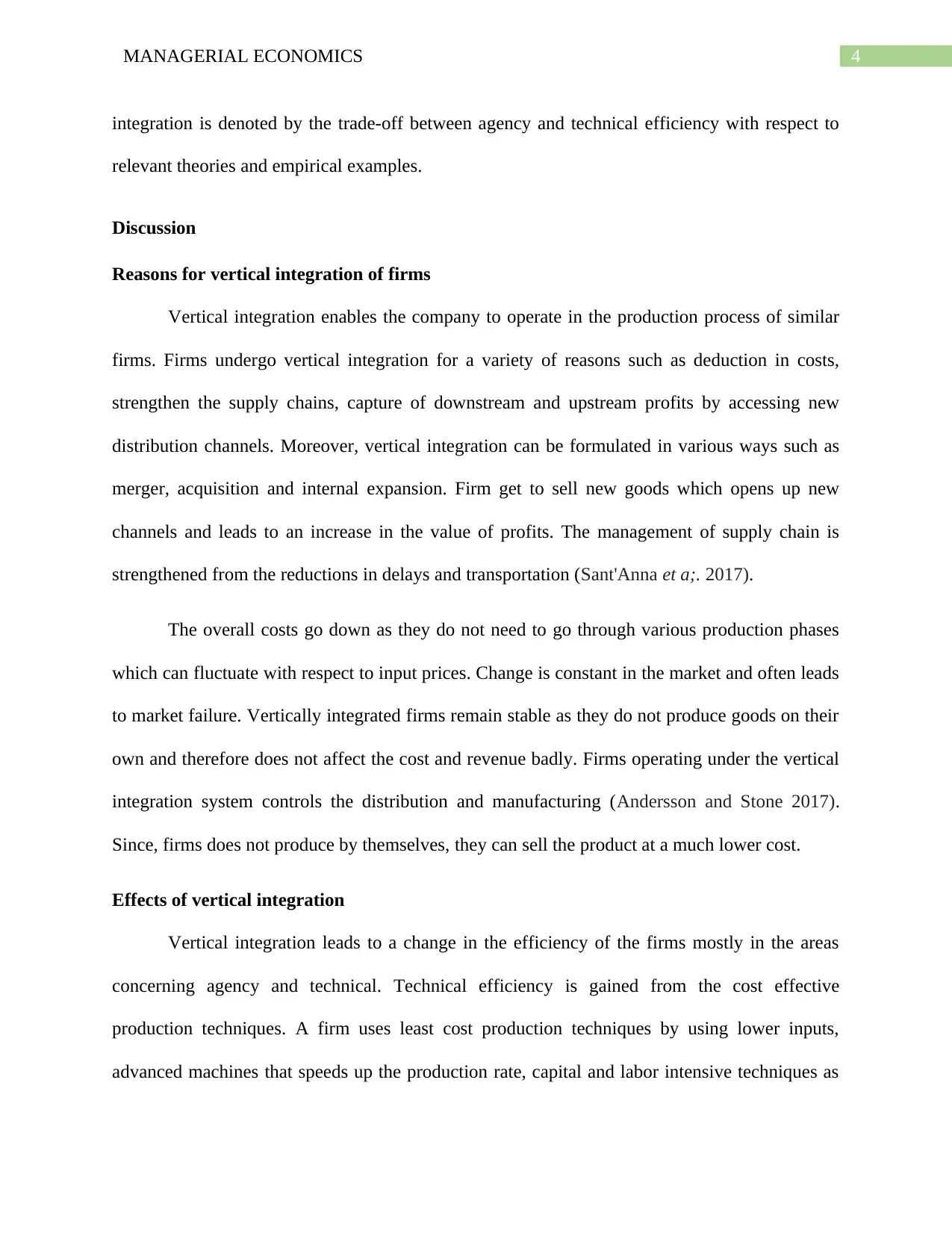
4MANAGERIAL ECONOMICS
integration is denoted by the trade-off between agency and technical efficiency with respect to
relevant theories and empirical examples.
Discussion
Reasons for vertical integration of firms
Vertical integration enables the company to operate in the production process of similar
firms. Firms undergo vertical integration for a variety of reasons such as deduction in costs,
strengthen the supply chains, capture of downstream and upstream profits by accessing new
distribution channels. Moreover, vertical integration can be formulated in various ways such as
merger, acquisition and internal expansion. Firm get to sell new goods which opens up new
channels and leads to an increase in the value of profits. The management of supply chain is
strengthened from the reductions in delays and transportation (Sant'Anna et a;. 2017).
The overall costs go down as they do not need to go through various production phases
which can fluctuate with respect to input prices. Change is constant in the market and often leads
to market failure. Vertically integrated firms remain stable as they do not produce goods on their
own and therefore does not affect the cost and revenue badly. Firms operating under the vertical
integration system controls the distribution and manufacturing (Andersson and Stone 2017).
Since, firms does not produce by themselves, they can sell the product at a much lower cost.
Effects of vertical integration
Vertical integration leads to a change in the efficiency of the firms mostly in the areas
concerning agency and technical. Technical efficiency is gained from the cost effective
production techniques. A firm uses least cost production techniques by using lower inputs,
advanced machines that speeds up the production rate, capital and labor intensive techniques as
integration is denoted by the trade-off between agency and technical efficiency with respect to
relevant theories and empirical examples.
Discussion
Reasons for vertical integration of firms
Vertical integration enables the company to operate in the production process of similar
firms. Firms undergo vertical integration for a variety of reasons such as deduction in costs,
strengthen the supply chains, capture of downstream and upstream profits by accessing new
distribution channels. Moreover, vertical integration can be formulated in various ways such as
merger, acquisition and internal expansion. Firm get to sell new goods which opens up new
channels and leads to an increase in the value of profits. The management of supply chain is
strengthened from the reductions in delays and transportation (Sant'Anna et a;. 2017).
The overall costs go down as they do not need to go through various production phases
which can fluctuate with respect to input prices. Change is constant in the market and often leads
to market failure. Vertically integrated firms remain stable as they do not produce goods on their
own and therefore does not affect the cost and revenue badly. Firms operating under the vertical
integration system controls the distribution and manufacturing (Andersson and Stone 2017).
Since, firms does not produce by themselves, they can sell the product at a much lower cost.
Effects of vertical integration
Vertical integration leads to a change in the efficiency of the firms mostly in the areas
concerning agency and technical. Technical efficiency is gained from the cost effective
production techniques. A firm uses least cost production techniques by using lower inputs,
advanced machines that speeds up the production rate, capital and labor intensive techniques as
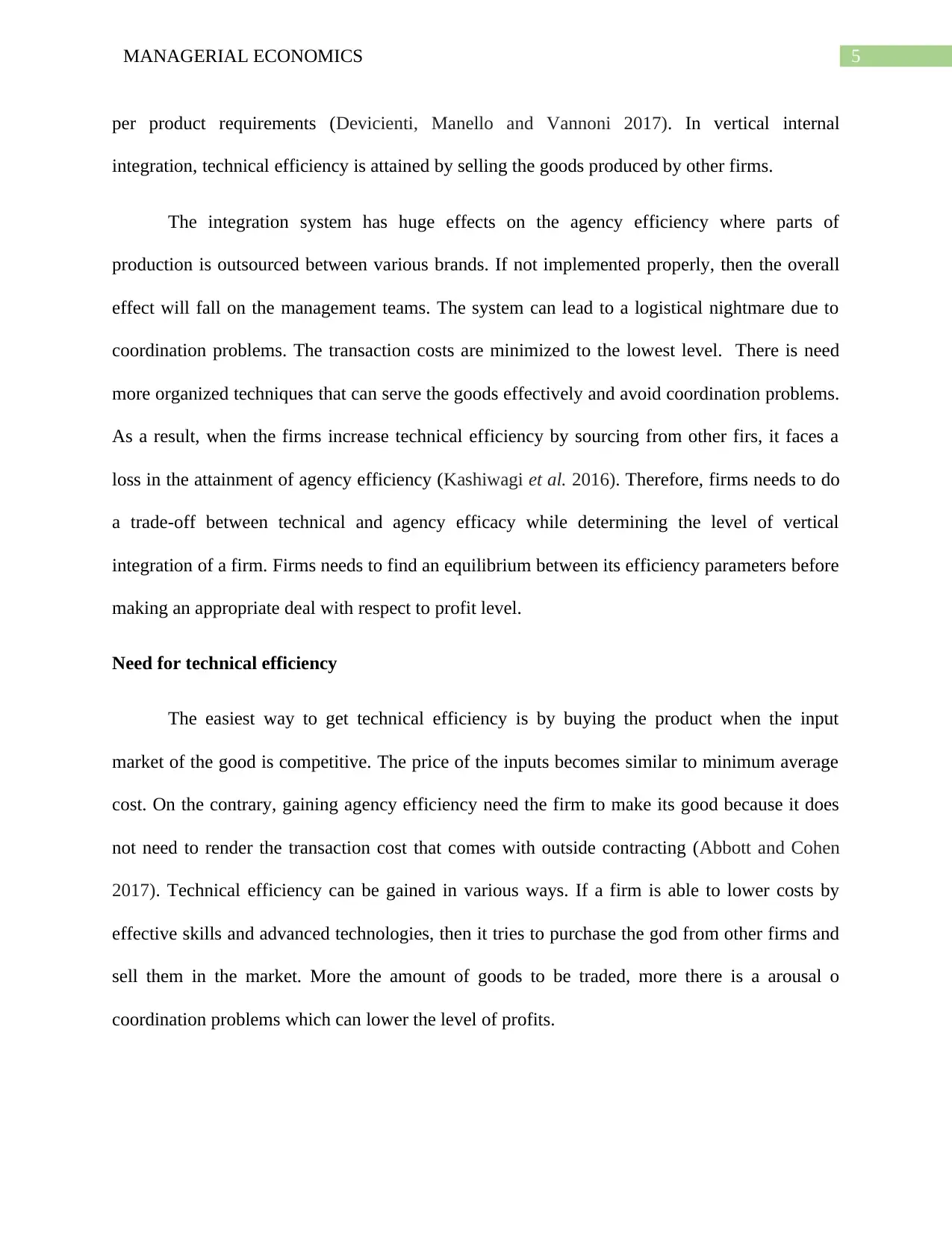
5MANAGERIAL ECONOMICS
per product requirements (Devicienti, Manello and Vannoni 2017). In vertical internal
integration, technical efficiency is attained by selling the goods produced by other firms.
The integration system has huge effects on the agency efficiency where parts of
production is outsourced between various brands. If not implemented properly, then the overall
effect will fall on the management teams. The system can lead to a logistical nightmare due to
coordination problems. The transaction costs are minimized to the lowest level. There is need
more organized techniques that can serve the goods effectively and avoid coordination problems.
As a result, when the firms increase technical efficiency by sourcing from other firs, it faces a
loss in the attainment of agency efficiency (Kashiwagi et al. 2016). Therefore, firms needs to do
a trade-off between technical and agency efficacy while determining the level of vertical
integration of a firm. Firms needs to find an equilibrium between its efficiency parameters before
making an appropriate deal with respect to profit level.
Need for technical efficiency
The easiest way to get technical efficiency is by buying the product when the input
market of the good is competitive. The price of the inputs becomes similar to minimum average
cost. On the contrary, gaining agency efficiency need the firm to make its good because it does
not need to render the transaction cost that comes with outside contracting (Abbott and Cohen
2017). Technical efficiency can be gained in various ways. If a firm is able to lower costs by
effective skills and advanced technologies, then it tries to purchase the god from other firms and
sell them in the market. More the amount of goods to be traded, more there is a arousal o
coordination problems which can lower the level of profits.
per product requirements (Devicienti, Manello and Vannoni 2017). In vertical internal
integration, technical efficiency is attained by selling the goods produced by other firms.
The integration system has huge effects on the agency efficiency where parts of
production is outsourced between various brands. If not implemented properly, then the overall
effect will fall on the management teams. The system can lead to a logistical nightmare due to
coordination problems. The transaction costs are minimized to the lowest level. There is need
more organized techniques that can serve the goods effectively and avoid coordination problems.
As a result, when the firms increase technical efficiency by sourcing from other firs, it faces a
loss in the attainment of agency efficiency (Kashiwagi et al. 2016). Therefore, firms needs to do
a trade-off between technical and agency efficacy while determining the level of vertical
integration of a firm. Firms needs to find an equilibrium between its efficiency parameters before
making an appropriate deal with respect to profit level.
Need for technical efficiency
The easiest way to get technical efficiency is by buying the product when the input
market of the good is competitive. The price of the inputs becomes similar to minimum average
cost. On the contrary, gaining agency efficiency need the firm to make its good because it does
not need to render the transaction cost that comes with outside contracting (Abbott and Cohen
2017). Technical efficiency can be gained in various ways. If a firm is able to lower costs by
effective skills and advanced technologies, then it tries to purchase the god from other firms and
sell them in the market. More the amount of goods to be traded, more there is a arousal o
coordination problems which can lower the level of profits.
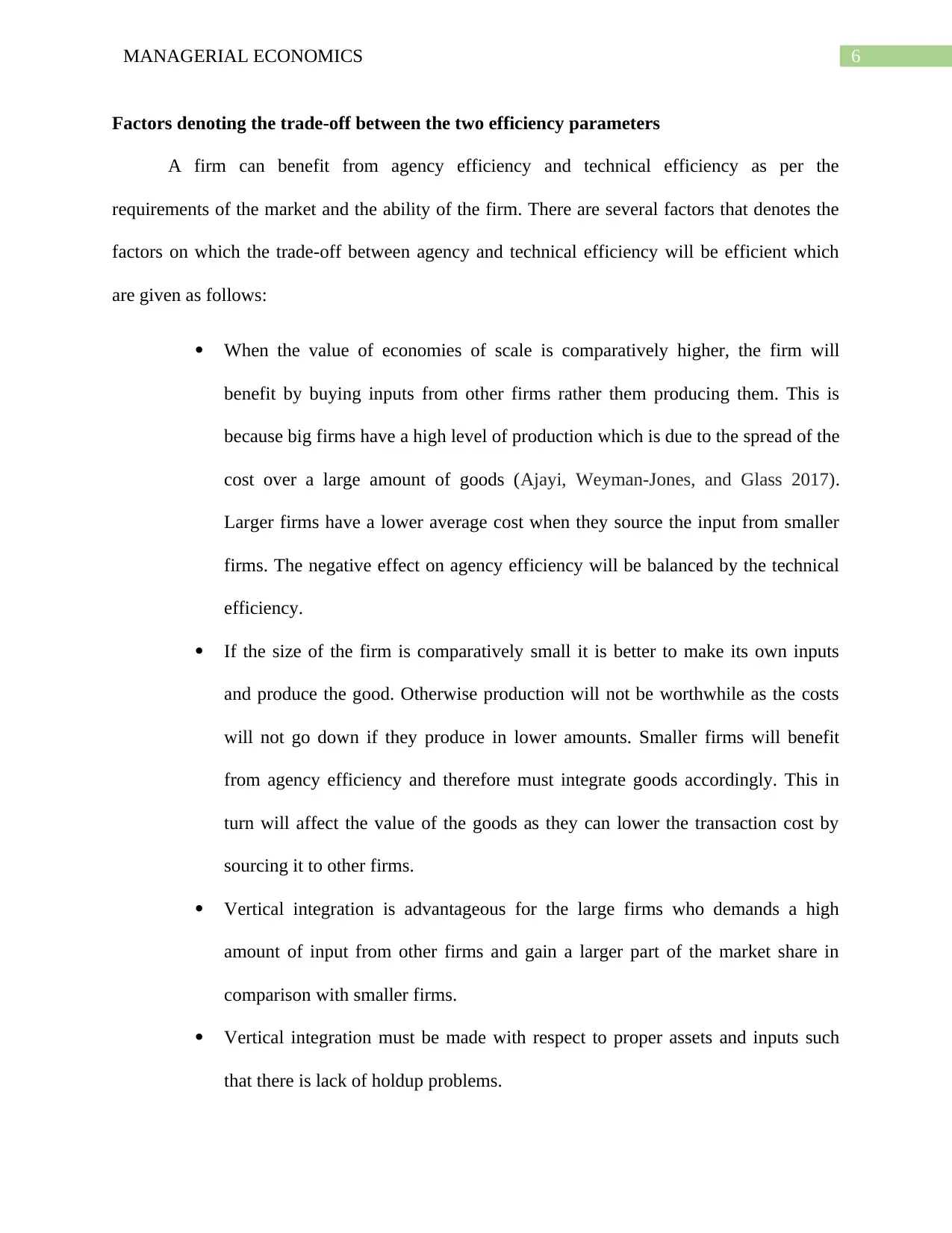
6MANAGERIAL ECONOMICS
Factors denoting the trade-off between the two efficiency parameters
A firm can benefit from agency efficiency and technical efficiency as per the
requirements of the market and the ability of the firm. There are several factors that denotes the
factors on which the trade-off between agency and technical efficiency will be efficient which
are given as follows:
When the value of economies of scale is comparatively higher, the firm will
benefit by buying inputs from other firms rather them producing them. This is
because big firms have a high level of production which is due to the spread of the
cost over a large amount of goods (Ajayi, Weyman-Jones, and Glass 2017).
Larger firms have a lower average cost when they source the input from smaller
firms. The negative effect on agency efficiency will be balanced by the technical
efficiency.
If the size of the firm is comparatively small it is better to make its own inputs
and produce the good. Otherwise production will not be worthwhile as the costs
will not go down if they produce in lower amounts. Smaller firms will benefit
from agency efficiency and therefore must integrate goods accordingly. This in
turn will affect the value of the goods as they can lower the transaction cost by
sourcing it to other firms.
Vertical integration is advantageous for the large firms who demands a high
amount of input from other firms and gain a larger part of the market share in
comparison with smaller firms.
Vertical integration must be made with respect to proper assets and inputs such
that there is lack of holdup problems.
Factors denoting the trade-off between the two efficiency parameters
A firm can benefit from agency efficiency and technical efficiency as per the
requirements of the market and the ability of the firm. There are several factors that denotes the
factors on which the trade-off between agency and technical efficiency will be efficient which
are given as follows:
When the value of economies of scale is comparatively higher, the firm will
benefit by buying inputs from other firms rather them producing them. This is
because big firms have a high level of production which is due to the spread of the
cost over a large amount of goods (Ajayi, Weyman-Jones, and Glass 2017).
Larger firms have a lower average cost when they source the input from smaller
firms. The negative effect on agency efficiency will be balanced by the technical
efficiency.
If the size of the firm is comparatively small it is better to make its own inputs
and produce the good. Otherwise production will not be worthwhile as the costs
will not go down if they produce in lower amounts. Smaller firms will benefit
from agency efficiency and therefore must integrate goods accordingly. This in
turn will affect the value of the goods as they can lower the transaction cost by
sourcing it to other firms.
Vertical integration is advantageous for the large firms who demands a high
amount of input from other firms and gain a larger part of the market share in
comparison with smaller firms.
Vertical integration must be made with respect to proper assets and inputs such
that there is lack of holdup problems.
Paraphrase This Document
Need a fresh take? Get an instant paraphrase of this document with our AI Paraphraser
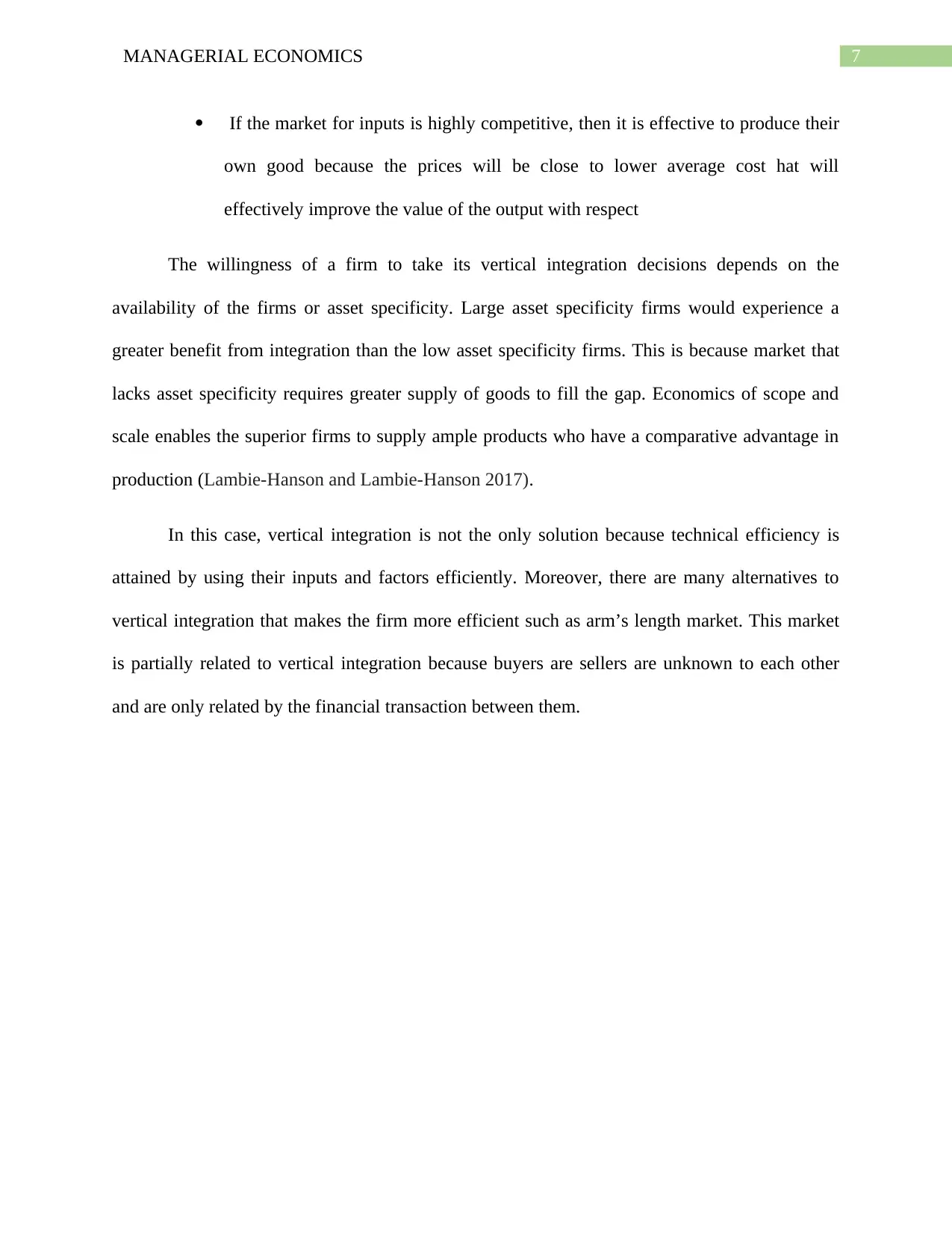
7MANAGERIAL ECONOMICS
If the market for inputs is highly competitive, then it is effective to produce their
own good because the prices will be close to lower average cost hat will
effectively improve the value of the output with respect
The willingness of a firm to take its vertical integration decisions depends on the
availability of the firms or asset specificity. Large asset specificity firms would experience a
greater benefit from integration than the low asset specificity firms. This is because market that
lacks asset specificity requires greater supply of goods to fill the gap. Economics of scope and
scale enables the superior firms to supply ample products who have a comparative advantage in
production (Lambie-Hanson and Lambie-Hanson 2017).
In this case, vertical integration is not the only solution because technical efficiency is
attained by using their inputs and factors efficiently. Moreover, there are many alternatives to
vertical integration that makes the firm more efficient such as arm’s length market. This market
is partially related to vertical integration because buyers are sellers are unknown to each other
and are only related by the financial transaction between them.
If the market for inputs is highly competitive, then it is effective to produce their
own good because the prices will be close to lower average cost hat will
effectively improve the value of the output with respect
The willingness of a firm to take its vertical integration decisions depends on the
availability of the firms or asset specificity. Large asset specificity firms would experience a
greater benefit from integration than the low asset specificity firms. This is because market that
lacks asset specificity requires greater supply of goods to fill the gap. Economics of scope and
scale enables the superior firms to supply ample products who have a comparative advantage in
production (Lambie-Hanson and Lambie-Hanson 2017).
In this case, vertical integration is not the only solution because technical efficiency is
attained by using their inputs and factors efficiently. Moreover, there are many alternatives to
vertical integration that makes the firm more efficient such as arm’s length market. This market
is partially related to vertical integration because buyers are sellers are unknown to each other
and are only related by the financial transaction between them.
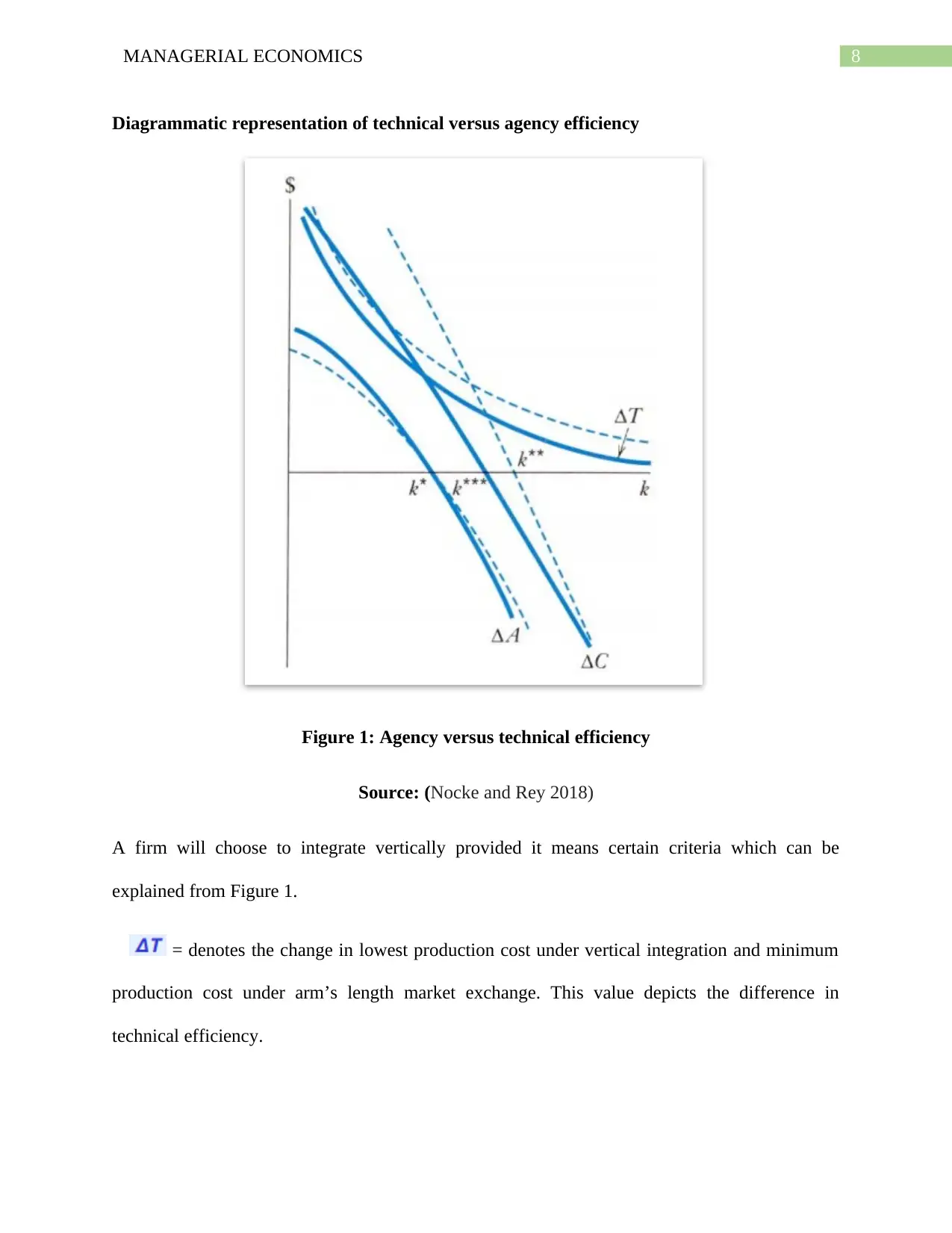
8MANAGERIAL ECONOMICS
Diagrammatic representation of technical versus agency efficiency
Figure 1: Agency versus technical efficiency
Source: (Nocke and Rey 2018)
A firm will choose to integrate vertically provided it means certain criteria which can be
explained from Figure 1.
= denotes the change in lowest production cost under vertical integration and minimum
production cost under arm’s length market exchange. This value depicts the difference in
technical efficiency.
Diagrammatic representation of technical versus agency efficiency
Figure 1: Agency versus technical efficiency
Source: (Nocke and Rey 2018)
A firm will choose to integrate vertically provided it means certain criteria which can be
explained from Figure 1.
= denotes the change in lowest production cost under vertical integration and minimum
production cost under arm’s length market exchange. This value depicts the difference in
technical efficiency.
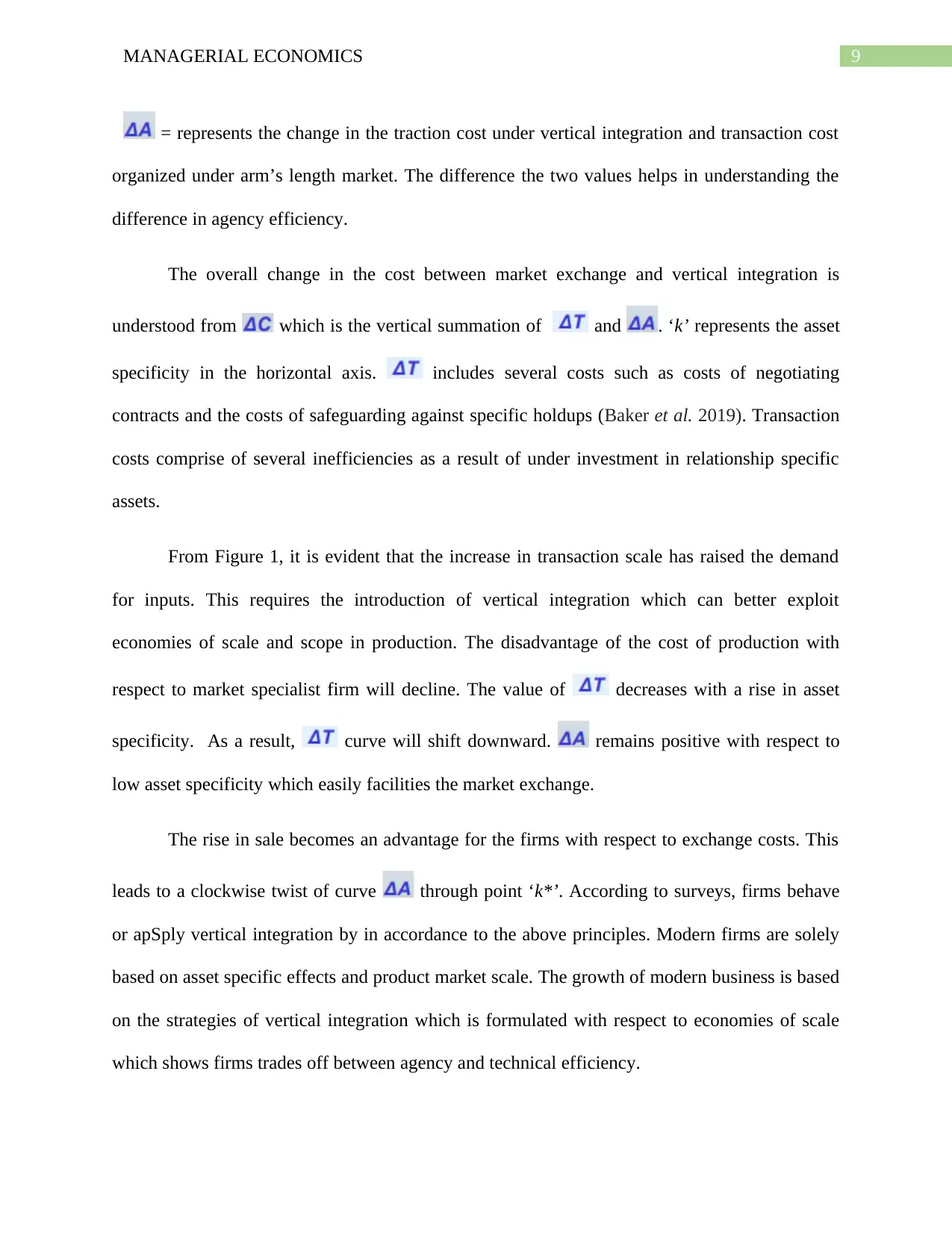
9MANAGERIAL ECONOMICS
= represents the change in the traction cost under vertical integration and transaction cost
organized under arm’s length market. The difference the two values helps in understanding the
difference in agency efficiency.
The overall change in the cost between market exchange and vertical integration is
understood from which is the vertical summation of and . ‘k’ represents the asset
specificity in the horizontal axis. includes several costs such as costs of negotiating
contracts and the costs of safeguarding against specific holdups (Baker et al. 2019). Transaction
costs comprise of several inefficiencies as a result of under investment in relationship specific
assets.
From Figure 1, it is evident that the increase in transaction scale has raised the demand
for inputs. This requires the introduction of vertical integration which can better exploit
economies of scale and scope in production. The disadvantage of the cost of production with
respect to market specialist firm will decline. The value of decreases with a rise in asset
specificity. As a result, curve will shift downward. remains positive with respect to
low asset specificity which easily facilities the market exchange.
The rise in sale becomes an advantage for the firms with respect to exchange costs. This
leads to a clockwise twist of curve through point ‘k*’. According to surveys, firms behave
or apSply vertical integration by in accordance to the above principles. Modern firms are solely
based on asset specific effects and product market scale. The growth of modern business is based
on the strategies of vertical integration which is formulated with respect to economies of scale
which shows firms trades off between agency and technical efficiency.
= represents the change in the traction cost under vertical integration and transaction cost
organized under arm’s length market. The difference the two values helps in understanding the
difference in agency efficiency.
The overall change in the cost between market exchange and vertical integration is
understood from which is the vertical summation of and . ‘k’ represents the asset
specificity in the horizontal axis. includes several costs such as costs of negotiating
contracts and the costs of safeguarding against specific holdups (Baker et al. 2019). Transaction
costs comprise of several inefficiencies as a result of under investment in relationship specific
assets.
From Figure 1, it is evident that the increase in transaction scale has raised the demand
for inputs. This requires the introduction of vertical integration which can better exploit
economies of scale and scope in production. The disadvantage of the cost of production with
respect to market specialist firm will decline. The value of decreases with a rise in asset
specificity. As a result, curve will shift downward. remains positive with respect to
low asset specificity which easily facilities the market exchange.
The rise in sale becomes an advantage for the firms with respect to exchange costs. This
leads to a clockwise twist of curve through point ‘k*’. According to surveys, firms behave
or apSply vertical integration by in accordance to the above principles. Modern firms are solely
based on asset specific effects and product market scale. The growth of modern business is based
on the strategies of vertical integration which is formulated with respect to economies of scale
which shows firms trades off between agency and technical efficiency.
Secure Best Marks with AI Grader
Need help grading? Try our AI Grader for instant feedback on your assignments.
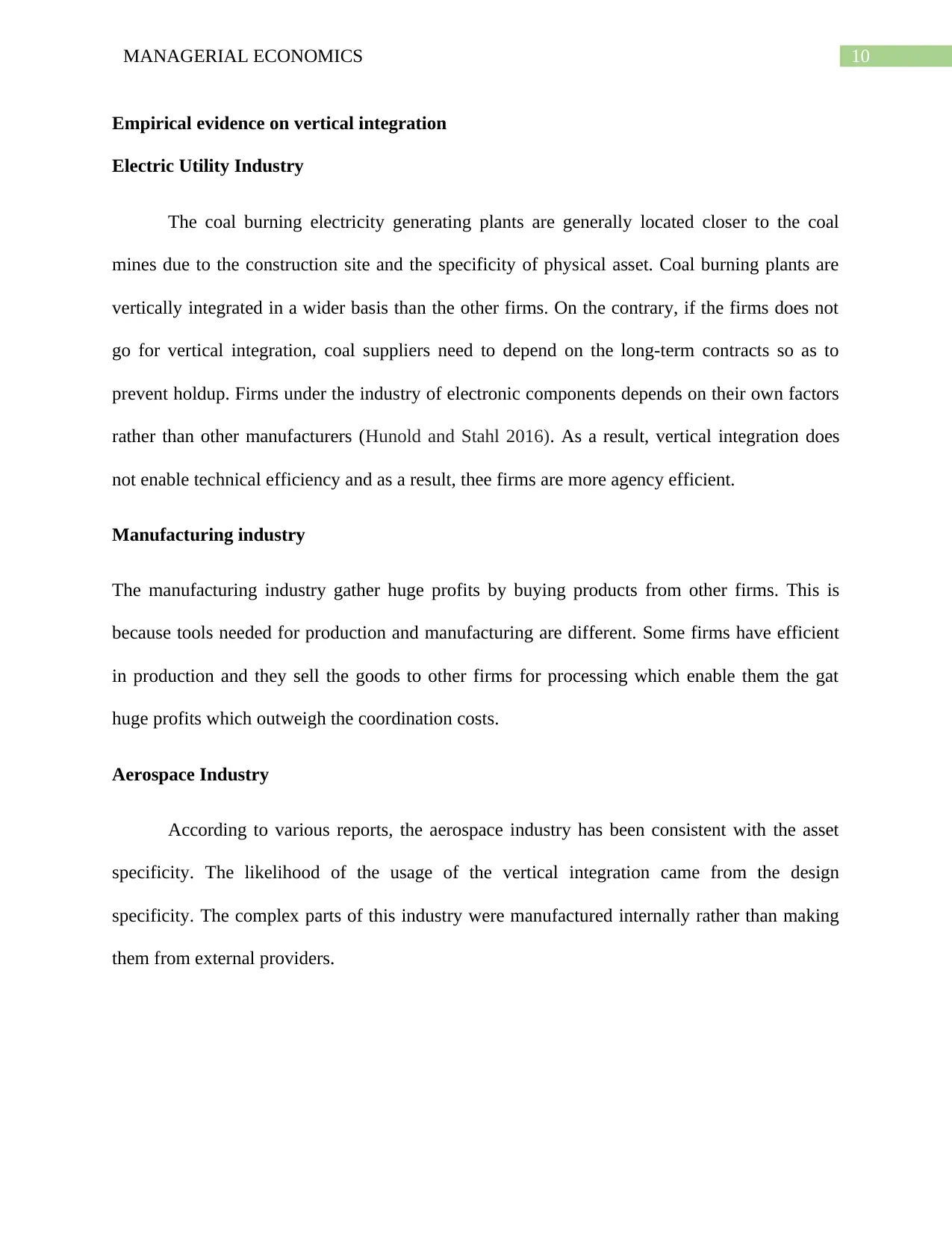
10MANAGERIAL ECONOMICS
Empirical evidence on vertical integration
Electric Utility Industry
The coal burning electricity generating plants are generally located closer to the coal
mines due to the construction site and the specificity of physical asset. Coal burning plants are
vertically integrated in a wider basis than the other firms. On the contrary, if the firms does not
go for vertical integration, coal suppliers need to depend on the long-term contracts so as to
prevent holdup. Firms under the industry of electronic components depends on their own factors
rather than other manufacturers (Hunold and Stahl 2016). As a result, vertical integration does
not enable technical efficiency and as a result, thee firms are more agency efficient.
Manufacturing industry
The manufacturing industry gather huge profits by buying products from other firms. This is
because tools needed for production and manufacturing are different. Some firms have efficient
in production and they sell the goods to other firms for processing which enable them the gat
huge profits which outweigh the coordination costs.
Aerospace Industry
According to various reports, the aerospace industry has been consistent with the asset
specificity. The likelihood of the usage of the vertical integration came from the design
specificity. The complex parts of this industry were manufactured internally rather than making
them from external providers.
Empirical evidence on vertical integration
Electric Utility Industry
The coal burning electricity generating plants are generally located closer to the coal
mines due to the construction site and the specificity of physical asset. Coal burning plants are
vertically integrated in a wider basis than the other firms. On the contrary, if the firms does not
go for vertical integration, coal suppliers need to depend on the long-term contracts so as to
prevent holdup. Firms under the industry of electronic components depends on their own factors
rather than other manufacturers (Hunold and Stahl 2016). As a result, vertical integration does
not enable technical efficiency and as a result, thee firms are more agency efficient.
Manufacturing industry
The manufacturing industry gather huge profits by buying products from other firms. This is
because tools needed for production and manufacturing are different. Some firms have efficient
in production and they sell the goods to other firms for processing which enable them the gat
huge profits which outweigh the coordination costs.
Aerospace Industry
According to various reports, the aerospace industry has been consistent with the asset
specificity. The likelihood of the usage of the vertical integration came from the design
specificity. The complex parts of this industry were manufactured internally rather than making
them from external providers.
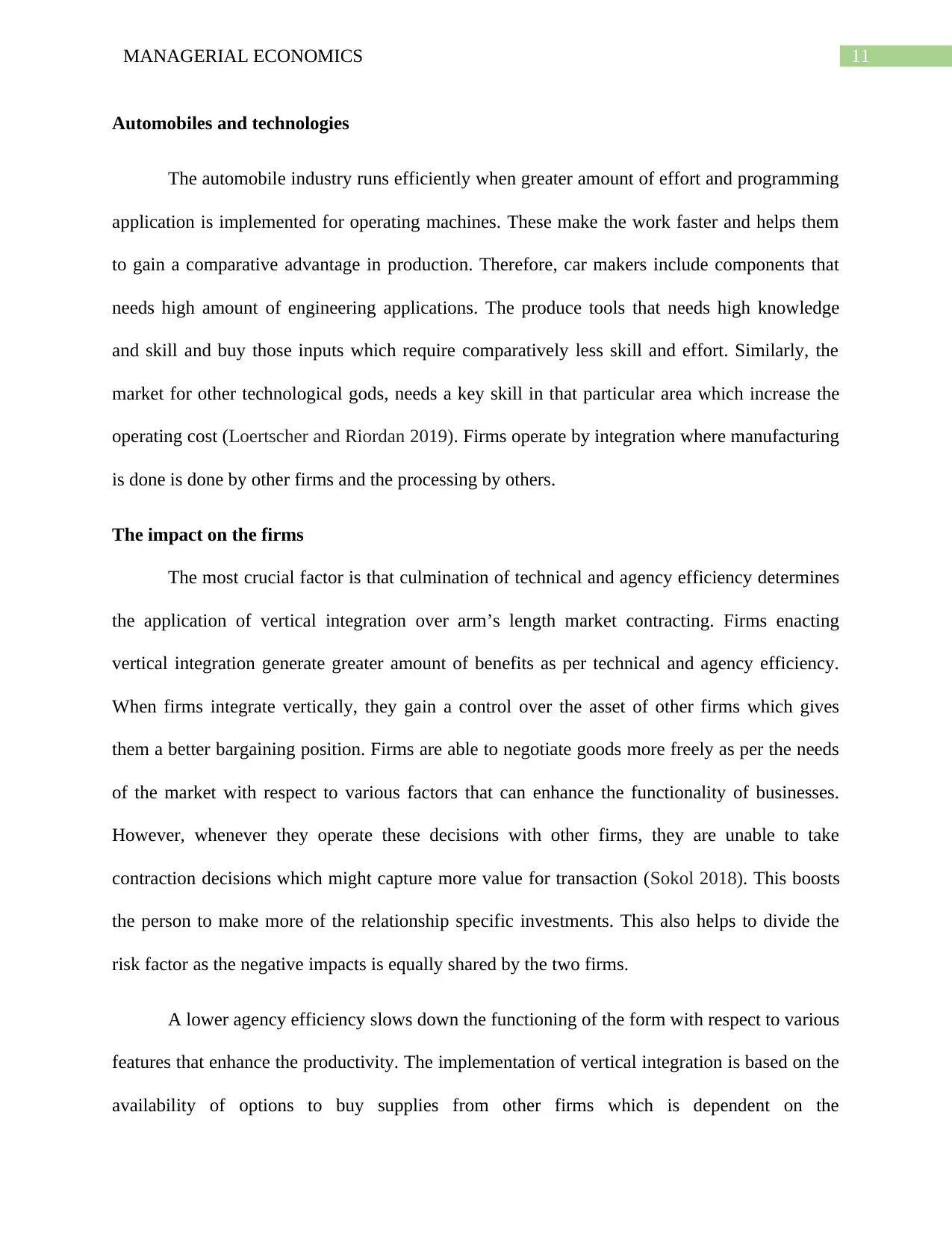
11MANAGERIAL ECONOMICS
Automobiles and technologies
The automobile industry runs efficiently when greater amount of effort and programming
application is implemented for operating machines. These make the work faster and helps them
to gain a comparative advantage in production. Therefore, car makers include components that
needs high amount of engineering applications. The produce tools that needs high knowledge
and skill and buy those inputs which require comparatively less skill and effort. Similarly, the
market for other technological gods, needs a key skill in that particular area which increase the
operating cost (Loertscher and Riordan 2019). Firms operate by integration where manufacturing
is done is done by other firms and the processing by others.
The impact on the firms
The most crucial factor is that culmination of technical and agency efficiency determines
the application of vertical integration over arm’s length market contracting. Firms enacting
vertical integration generate greater amount of benefits as per technical and agency efficiency.
When firms integrate vertically, they gain a control over the asset of other firms which gives
them a better bargaining position. Firms are able to negotiate goods more freely as per the needs
of the market with respect to various factors that can enhance the functionality of businesses.
However, whenever they operate these decisions with other firms, they are unable to take
contraction decisions which might capture more value for transaction (Sokol 2018). This boosts
the person to make more of the relationship specific investments. This also helps to divide the
risk factor as the negative impacts is equally shared by the two firms.
A lower agency efficiency slows down the functioning of the form with respect to various
features that enhance the productivity. The implementation of vertical integration is based on the
availability of options to buy supplies from other firms which is dependent on the
Automobiles and technologies
The automobile industry runs efficiently when greater amount of effort and programming
application is implemented for operating machines. These make the work faster and helps them
to gain a comparative advantage in production. Therefore, car makers include components that
needs high amount of engineering applications. The produce tools that needs high knowledge
and skill and buy those inputs which require comparatively less skill and effort. Similarly, the
market for other technological gods, needs a key skill in that particular area which increase the
operating cost (Loertscher and Riordan 2019). Firms operate by integration where manufacturing
is done is done by other firms and the processing by others.
The impact on the firms
The most crucial factor is that culmination of technical and agency efficiency determines
the application of vertical integration over arm’s length market contracting. Firms enacting
vertical integration generate greater amount of benefits as per technical and agency efficiency.
When firms integrate vertically, they gain a control over the asset of other firms which gives
them a better bargaining position. Firms are able to negotiate goods more freely as per the needs
of the market with respect to various factors that can enhance the functionality of businesses.
However, whenever they operate these decisions with other firms, they are unable to take
contraction decisions which might capture more value for transaction (Sokol 2018). This boosts
the person to make more of the relationship specific investments. This also helps to divide the
risk factor as the negative impacts is equally shared by the two firms.
A lower agency efficiency slows down the functioning of the form with respect to various
features that enhance the productivity. The implementation of vertical integration is based on the
availability of options to buy supplies from other firms which is dependent on the
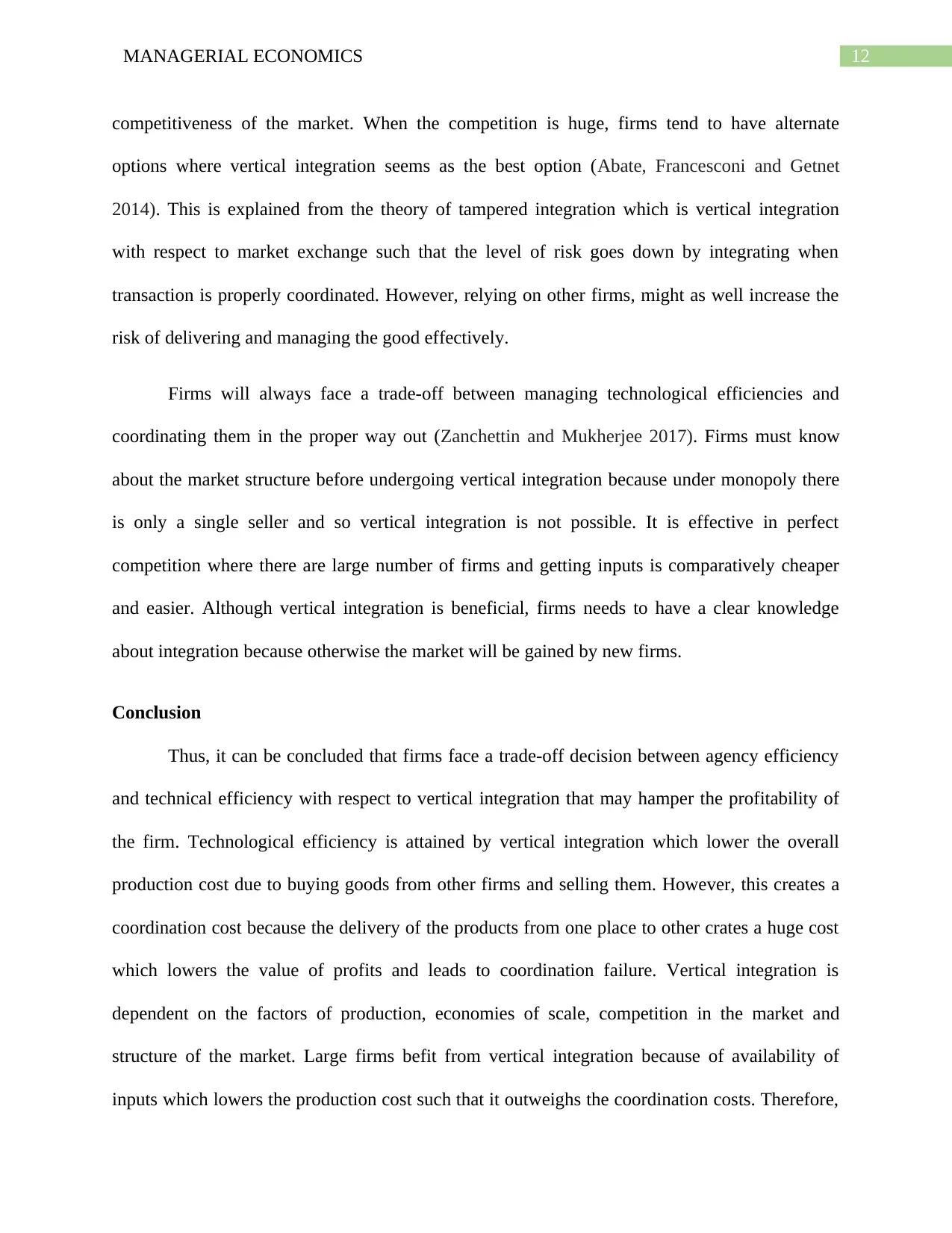
12MANAGERIAL ECONOMICS
competitiveness of the market. When the competition is huge, firms tend to have alternate
options where vertical integration seems as the best option (Abate, Francesconi and Getnet
2014). This is explained from the theory of tampered integration which is vertical integration
with respect to market exchange such that the level of risk goes down by integrating when
transaction is properly coordinated. However, relying on other firms, might as well increase the
risk of delivering and managing the good effectively.
Firms will always face a trade-off between managing technological efficiencies and
coordinating them in the proper way out (Zanchettin and Mukherjee 2017). Firms must know
about the market structure before undergoing vertical integration because under monopoly there
is only a single seller and so vertical integration is not possible. It is effective in perfect
competition where there are large number of firms and getting inputs is comparatively cheaper
and easier. Although vertical integration is beneficial, firms needs to have a clear knowledge
about integration because otherwise the market will be gained by new firms.
Conclusion
Thus, it can be concluded that firms face a trade-off decision between agency efficiency
and technical efficiency with respect to vertical integration that may hamper the profitability of
the firm. Technological efficiency is attained by vertical integration which lower the overall
production cost due to buying goods from other firms and selling them. However, this creates a
coordination cost because the delivery of the products from one place to other crates a huge cost
which lowers the value of profits and leads to coordination failure. Vertical integration is
dependent on the factors of production, economies of scale, competition in the market and
structure of the market. Large firms befit from vertical integration because of availability of
inputs which lowers the production cost such that it outweighs the coordination costs. Therefore,
competitiveness of the market. When the competition is huge, firms tend to have alternate
options where vertical integration seems as the best option (Abate, Francesconi and Getnet
2014). This is explained from the theory of tampered integration which is vertical integration
with respect to market exchange such that the level of risk goes down by integrating when
transaction is properly coordinated. However, relying on other firms, might as well increase the
risk of delivering and managing the good effectively.
Firms will always face a trade-off between managing technological efficiencies and
coordinating them in the proper way out (Zanchettin and Mukherjee 2017). Firms must know
about the market structure before undergoing vertical integration because under monopoly there
is only a single seller and so vertical integration is not possible. It is effective in perfect
competition where there are large number of firms and getting inputs is comparatively cheaper
and easier. Although vertical integration is beneficial, firms needs to have a clear knowledge
about integration because otherwise the market will be gained by new firms.
Conclusion
Thus, it can be concluded that firms face a trade-off decision between agency efficiency
and technical efficiency with respect to vertical integration that may hamper the profitability of
the firm. Technological efficiency is attained by vertical integration which lower the overall
production cost due to buying goods from other firms and selling them. However, this creates a
coordination cost because the delivery of the products from one place to other crates a huge cost
which lowers the value of profits and leads to coordination failure. Vertical integration is
dependent on the factors of production, economies of scale, competition in the market and
structure of the market. Large firms befit from vertical integration because of availability of
inputs which lowers the production cost such that it outweighs the coordination costs. Therefore,
Paraphrase This Document
Need a fresh take? Get an instant paraphrase of this document with our AI Paraphraser
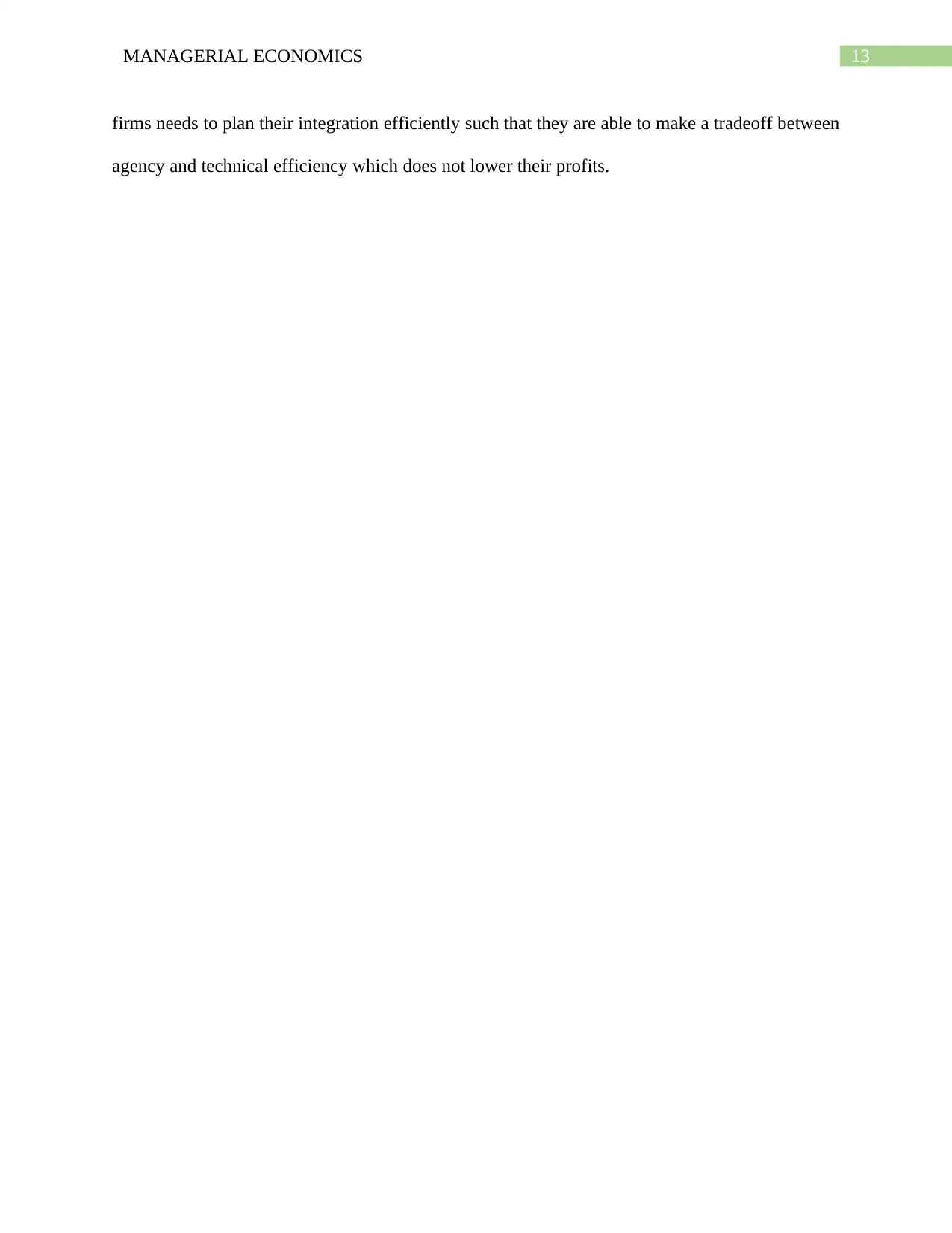
13MANAGERIAL ECONOMICS
firms needs to plan their integration efficiently such that they are able to make a tradeoff between
agency and technical efficiency which does not lower their profits.
firms needs to plan their integration efficiently such that they are able to make a tradeoff between
agency and technical efficiency which does not lower their profits.
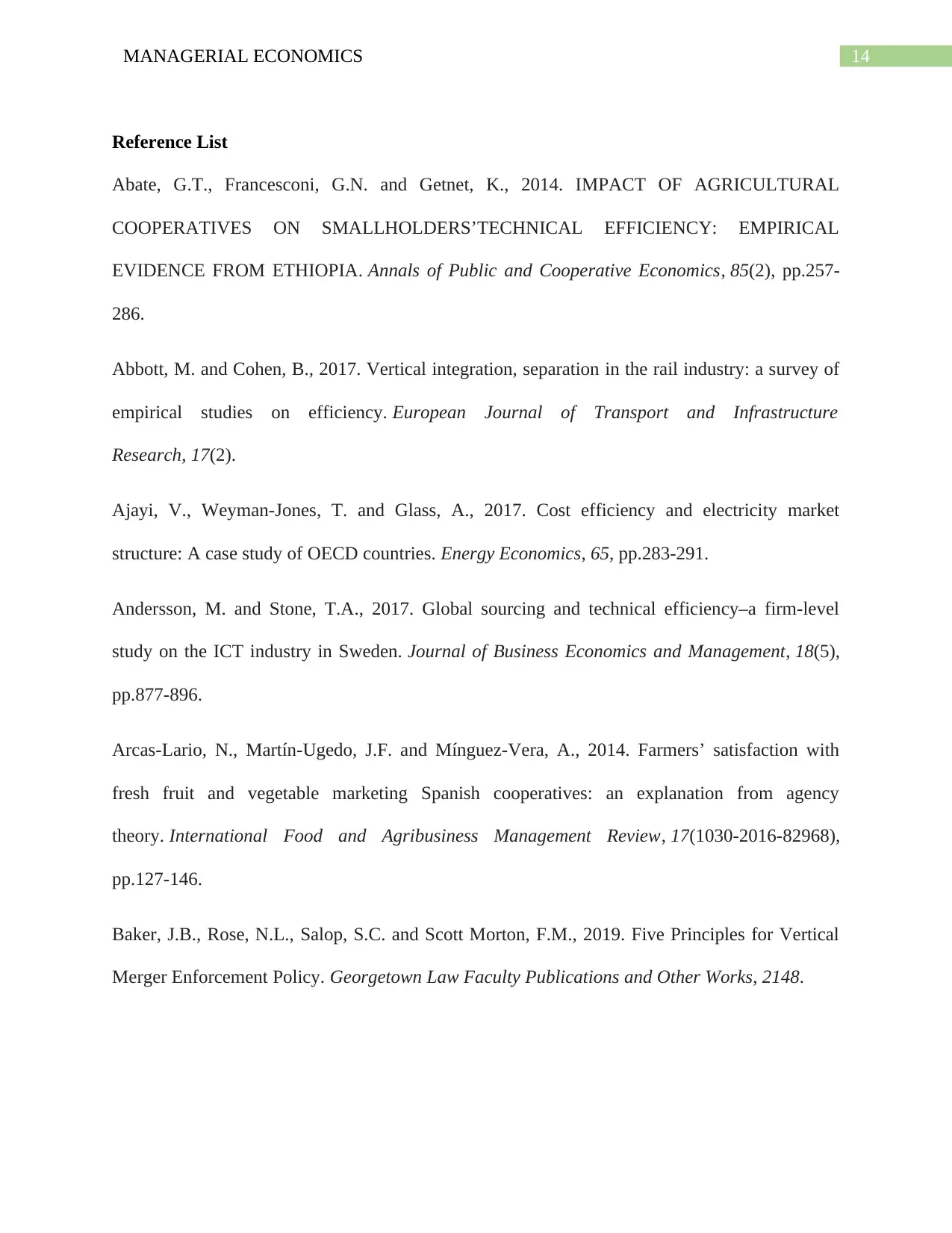
14MANAGERIAL ECONOMICS
Reference List
Abate, G.T., Francesconi, G.N. and Getnet, K., 2014. IMPACT OF AGRICULTURAL
COOPERATIVES ON SMALLHOLDERS’TECHNICAL EFFICIENCY: EMPIRICAL
EVIDENCE FROM ETHIOPIA. Annals of Public and Cooperative Economics, 85(2), pp.257-
286.
Abbott, M. and Cohen, B., 2017. Vertical integration, separation in the rail industry: a survey of
empirical studies on efficiency. European Journal of Transport and Infrastructure
Research, 17(2).
Ajayi, V., Weyman-Jones, T. and Glass, A., 2017. Cost efficiency and electricity market
structure: A case study of OECD countries. Energy Economics, 65, pp.283-291.
Andersson, M. and Stone, T.A., 2017. Global sourcing and technical efficiency–a firm-level
study on the ICT industry in Sweden. Journal of Business Economics and Management, 18(5),
pp.877-896.
Arcas-Lario, N., Martín-Ugedo, J.F. and Mínguez-Vera, A., 2014. Farmers’ satisfaction with
fresh fruit and vegetable marketing Spanish cooperatives: an explanation from agency
theory. International Food and Agribusiness Management Review, 17(1030-2016-82968),
pp.127-146.
Baker, J.B., Rose, N.L., Salop, S.C. and Scott Morton, F.M., 2019. Five Principles for Vertical
Merger Enforcement Policy. Georgetown Law Faculty Publications and Other Works, 2148.
Reference List
Abate, G.T., Francesconi, G.N. and Getnet, K., 2014. IMPACT OF AGRICULTURAL
COOPERATIVES ON SMALLHOLDERS’TECHNICAL EFFICIENCY: EMPIRICAL
EVIDENCE FROM ETHIOPIA. Annals of Public and Cooperative Economics, 85(2), pp.257-
286.
Abbott, M. and Cohen, B., 2017. Vertical integration, separation in the rail industry: a survey of
empirical studies on efficiency. European Journal of Transport and Infrastructure
Research, 17(2).
Ajayi, V., Weyman-Jones, T. and Glass, A., 2017. Cost efficiency and electricity market
structure: A case study of OECD countries. Energy Economics, 65, pp.283-291.
Andersson, M. and Stone, T.A., 2017. Global sourcing and technical efficiency–a firm-level
study on the ICT industry in Sweden. Journal of Business Economics and Management, 18(5),
pp.877-896.
Arcas-Lario, N., Martín-Ugedo, J.F. and Mínguez-Vera, A., 2014. Farmers’ satisfaction with
fresh fruit and vegetable marketing Spanish cooperatives: an explanation from agency
theory. International Food and Agribusiness Management Review, 17(1030-2016-82968),
pp.127-146.
Baker, J.B., Rose, N.L., Salop, S.C. and Scott Morton, F.M., 2019. Five Principles for Vertical
Merger Enforcement Policy. Georgetown Law Faculty Publications and Other Works, 2148.
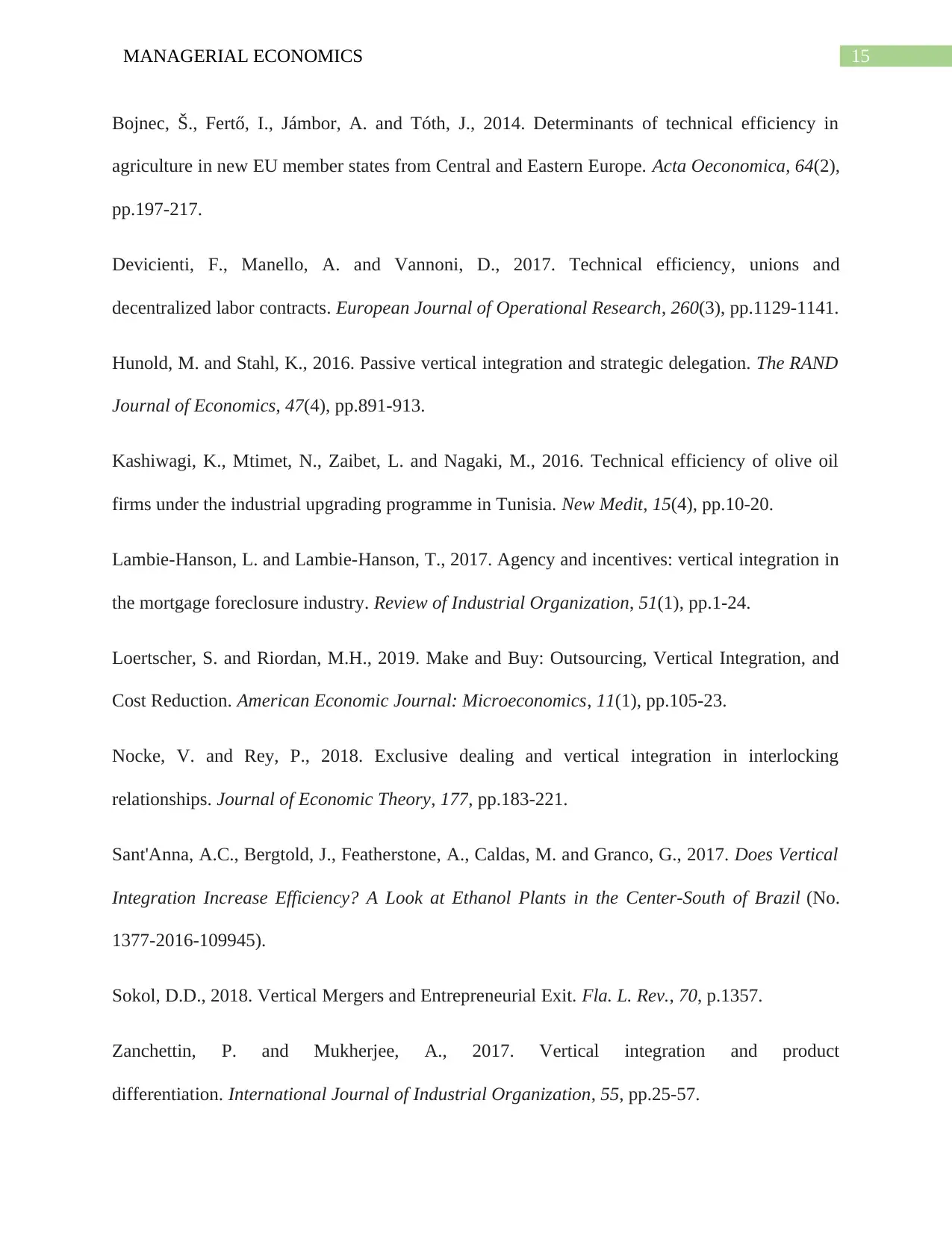
15MANAGERIAL ECONOMICS
Bojnec, Š., Fertő, I., Jámbor, A. and Tóth, J., 2014. Determinants of technical efficiency in
agriculture in new EU member states from Central and Eastern Europe. Acta Oeconomica, 64(2),
pp.197-217.
Devicienti, F., Manello, A. and Vannoni, D., 2017. Technical efficiency, unions and
decentralized labor contracts. European Journal of Operational Research, 260(3), pp.1129-1141.
Hunold, M. and Stahl, K., 2016. Passive vertical integration and strategic delegation. The RAND
Journal of Economics, 47(4), pp.891-913.
Kashiwagi, K., Mtimet, N., Zaibet, L. and Nagaki, M., 2016. Technical efficiency of olive oil
firms under the industrial upgrading programme in Tunisia. New Medit, 15(4), pp.10-20.
Lambie-Hanson, L. and Lambie-Hanson, T., 2017. Agency and incentives: vertical integration in
the mortgage foreclosure industry. Review of Industrial Organization, 51(1), pp.1-24.
Loertscher, S. and Riordan, M.H., 2019. Make and Buy: Outsourcing, Vertical Integration, and
Cost Reduction. American Economic Journal: Microeconomics, 11(1), pp.105-23.
Nocke, V. and Rey, P., 2018. Exclusive dealing and vertical integration in interlocking
relationships. Journal of Economic Theory, 177, pp.183-221.
Sant'Anna, A.C., Bergtold, J., Featherstone, A., Caldas, M. and Granco, G., 2017. Does Vertical
Integration Increase Efficiency? A Look at Ethanol Plants in the Center-South of Brazil (No.
1377-2016-109945).
Sokol, D.D., 2018. Vertical Mergers and Entrepreneurial Exit. Fla. L. Rev., 70, p.1357.
Zanchettin, P. and Mukherjee, A., 2017. Vertical integration and product
differentiation. International Journal of Industrial Organization, 55, pp.25-57.
Bojnec, Š., Fertő, I., Jámbor, A. and Tóth, J., 2014. Determinants of technical efficiency in
agriculture in new EU member states from Central and Eastern Europe. Acta Oeconomica, 64(2),
pp.197-217.
Devicienti, F., Manello, A. and Vannoni, D., 2017. Technical efficiency, unions and
decentralized labor contracts. European Journal of Operational Research, 260(3), pp.1129-1141.
Hunold, M. and Stahl, K., 2016. Passive vertical integration and strategic delegation. The RAND
Journal of Economics, 47(4), pp.891-913.
Kashiwagi, K., Mtimet, N., Zaibet, L. and Nagaki, M., 2016. Technical efficiency of olive oil
firms under the industrial upgrading programme in Tunisia. New Medit, 15(4), pp.10-20.
Lambie-Hanson, L. and Lambie-Hanson, T., 2017. Agency and incentives: vertical integration in
the mortgage foreclosure industry. Review of Industrial Organization, 51(1), pp.1-24.
Loertscher, S. and Riordan, M.H., 2019. Make and Buy: Outsourcing, Vertical Integration, and
Cost Reduction. American Economic Journal: Microeconomics, 11(1), pp.105-23.
Nocke, V. and Rey, P., 2018. Exclusive dealing and vertical integration in interlocking
relationships. Journal of Economic Theory, 177, pp.183-221.
Sant'Anna, A.C., Bergtold, J., Featherstone, A., Caldas, M. and Granco, G., 2017. Does Vertical
Integration Increase Efficiency? A Look at Ethanol Plants in the Center-South of Brazil (No.
1377-2016-109945).
Sokol, D.D., 2018. Vertical Mergers and Entrepreneurial Exit. Fla. L. Rev., 70, p.1357.
Zanchettin, P. and Mukherjee, A., 2017. Vertical integration and product
differentiation. International Journal of Industrial Organization, 55, pp.25-57.
Secure Best Marks with AI Grader
Need help grading? Try our AI Grader for instant feedback on your assignments.

16MANAGERIAL ECONOMICS
1 out of 17
Related Documents
Your All-in-One AI-Powered Toolkit for Academic Success.
+13062052269
info@desklib.com
Available 24*7 on WhatsApp / Email
![[object Object]](/_next/static/media/star-bottom.7253800d.svg)
Unlock your academic potential
© 2024 | Zucol Services PVT LTD | All rights reserved.





